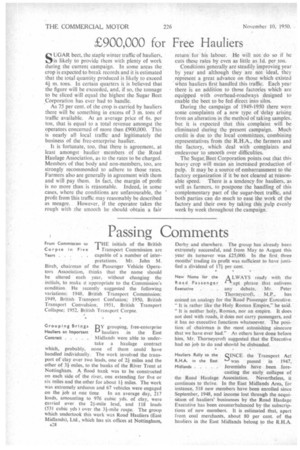£900,000 for Free Hauliers
Page 30

If you've noticed an error in this article please click here to report it so we can fix it.
SUGAR beet, the staple winter traffic of hauliers, is likely to provide them with plenty of work during the current campaign. In some areas the crop is expected to break records and it is estimated that the total quantity produced is likely to exceed 41 m. tons. In certain quarters it is believed that the figure will be exceeded, and, if so, the tonnage to be sliced will equal the highest the Sugar Beet Corporation has ever had to handle.
As 75 per cent. of the crop is carried by hauliers there will be something in excess of 3 m. tons of traffic available. At an average price of 6s. per ton, that is equal to a total revenue amongst the operators concerned of more than E900,000. This is nearly all local traffic and legitimately the business of the free-enterprise haulier.
It is fortunate, too, that there is agreement, at least amongst haulier members of the Road Haulage Association, as to the rates to be charged. Members of that body and non-members, too, are strongly recommended to adhere to those rates. Farmers also are generally in agreement with them and will pay them. In fact, the margin of profit is no more than is reasonable. Indeed, in some cases, where the conditions are unfavourable, the profit from this traffic may reasonably be described as meagre. However, if the operator takes the rough with the smooth he should obtain a fair return for his labour. He will not do so if he cuts these rates by even as little as Id. per ton. Conditions generally are steadily improving year by year and although they are not ideal, they represent a great advance on those which existed when hauliers first handled this traffic. Each year there is an addition to those factories which are equipped with overhead-roadways designed to enable the beet to be fed direct into silos.
During the campaign of 1949-1950 there were some complaints of a new type of 'delay arising from an alteration in the method of taking samples. but it is expected that this complaint will be eliminated during the present campaign. Much credit is due to the local committees, combining representatives from the R.H.A., the farmers and the factory, which deal with complaints and endeavour to smooth over difficulties.
The Sugar. Beet Corporation points out that this heavy crop will mean an increased production of pulp. It may be a source of embarrassment to the factory organization if it be not cleared at reasonable speed. There is a tendency for hauliers, as well as farmers, to postpone the handling of this complementary part of the sugar-beet traffic, and both parties can do much to ease the work of the factory and their own by taking this pulp evenly week by week throughout the campaign.




















































































